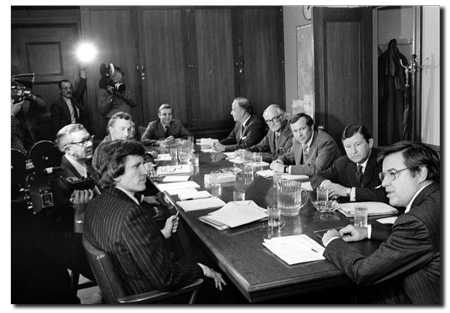The US Senate Church Committee, the White House and the CIA
Church Committee, White House and CIA
White House Efforts to Blunt 1975 Church Committee Investigation into CIA Abuses Foreshadowed Executive-Congressional Battles after 9/11
Advisers to President Ford Sought to Protect CIA’s Image Abroad by Having Its Capabilities “Cloaked in Mystery and Held in Awe”
Ford Administration Stratagem of Withholding Sensitive Intelligence, Spearheaded by Dick Cheney, Set Tone for Future Clashes between Claims of Secrecy and Public’s Right to Know

Members of the “Church Committee” meet in Washington, D.C., February 6, 1975. (Source: Henry Griffin / AP)
Washington, D.C., July 20, 2015 - Forty years ago this year, Congress’s first serious inquiry into CIA abuses faced many of the same political and bureaucratic obstructions as Senate investigators have confronted in assessing Intelligence Community performance since the September 11, 2001, terrorist attacks. Records posted today for the first time by the National Security Archive document the often rough-and-tumble, behind-the-scenes dynamics between Congress and the Executive Branch during the “Year of Intelligence” – highlighted by the investigations of the congressional Church and Pike committees.
Among White House and Intelligence Community stated concerns during the period of the Church and Pike inquiries were preserving the effectiveness of the CIA and reassuring future operatives who might fear their “heads may be on the block” for their actions, no matter how well-intentioned. But intelligence officials also worried that disclosures of agency operations would be “disastrous” for CIA’s standing in the world: “We are a great power and it is important that we be perceived as such,” a memo to the president warned, urging that “our intelligence capability to a certain extent be cloaked in mystery and held in awe.”
In 1975, it was then-Deputy Chief of Staff Dick Cheney who spearheaded the Ford White House’s hostile approach to Congress, which required the CIA to submit all proposed responses to Capitol Hill for prior presidential approval and featured the explicit intent to keep investigators away from the most sensitive records. Those events presaged the battles between the Senate Select Committee on Intelligence (SSCI) and the U.S. Intelligence Community since 2012 over plans to publish the former’s 6,000-page report on the CIA’s rendition, detention and interrogation program.
Related to today’s posting, a much larger compilation of 1,000 documents, many of them previously classified, was published in June 2015 in the online collection CIA Covert Operations II: The Year of Intelligence, 1975, the second in a series on the CIA through the Digital National Security Archive, a joint project with the scholarly publisher ProQuest.
Etiquetas: Church Committee, CIA, eng, National Security Archive

0 Comentarios:
Publicar un comentario
Suscribirse a Comentarios de la entrada [Atom]
<< Página Principal